
Cividale del Friuli is a town and comune (municipality) in the Regional decentralization entity of Udine, part of the North-Italian region of Friuli-Venezia Giulia. The town lies 135 metres (443 ft) above sea-level in the foothills of the eastern Alps, 15 kilometres (9 mi) by rail from the city of Udine and close to the Slovenian border. It is situated on the river Natisone, which forms a picturesque ravine here. Formerly an important regional power, it is today a quiet, small town that attracts tourists thanks to its medieval center.

Adro is a town and comune in the province of Brescia, in Lombardy, with a traditional wine-growing vocation favored by its position in the Franciacorta area.
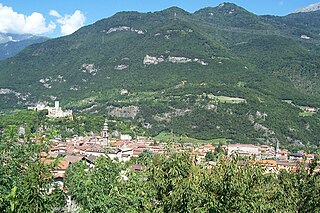
Breno is an Italian comune of 4,986 inhabitants in Val Camonica, province of Brescia, in Lombardy.
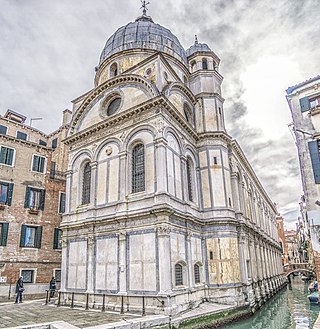
Lombardo, the name of a family of Venetian sculptors and architects; their surname was apparently Solaro, and the name of Lombardo was given to the earliest known, Martino, who emigrated from Lombardy to Venice in the middle of the 15th century AD and became celebrated as an architect.

The Domini di Terraferma was the hinterland territories of the Republic of Venice beyond the Adriatic coast in Northeast Italy. They were one of the three subdivisions of the Republic's possessions, the other two being the original Dogado (Duchy) and the Stato da Màr.

The Stato da Màr or Domini da Mar was the Republic of Venice's maritime and overseas possessions from around 1000 to 1797, including at various times parts of what are now Istria, Dalmatia, Montenegro, Albania, Greece and notably the Ionian Islands, Peloponnese, Crete, Cyclades, Euboea, as well as Cyprus.

San Lio is a church located on the campo of the same name in the sestiere of Castello.
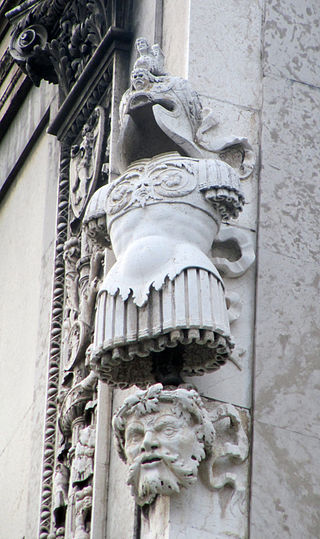
Gasparo Cairano, also known as Gasparo da Cairano, de Cayrano, da Milano, Coirano, and other variations, was an Italian Renaissance sculptor.

Brescia is a city and comune in the region of Lombardy, in Northern Italy. It is situated at the foot of the Alps, a few kilometers from the lakes Garda and Iseo. With a population of more than 200,000, it is the second largest city in Lombardy and the fourth largest in northwest Italy. The urban area of Brescia extends beyond the administrative city limits and has a population of 672,822, while over 1.5 million people live in its metropolitan area. The city is the administrative capital of the Province of Brescia, one of the largest in Italy, with over 1,200,000 inhabitants.
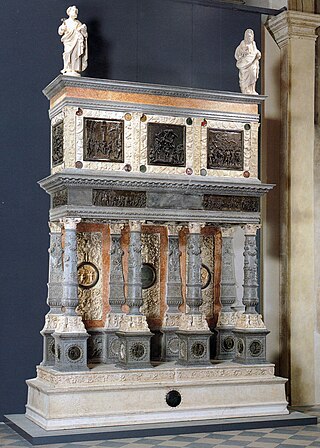
Bernardino delle Croci was an Italian goldsmith and sculptor of the Brescian Renaissance. He was the founder of the Delle Croci family of important goldsmiths and sculptors, known for their specialism in processional crosses, reliquaries and altars.
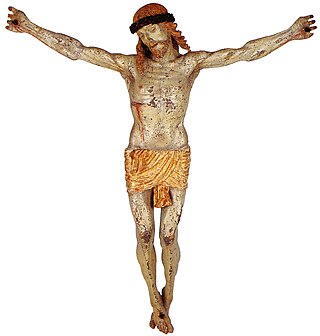
Maffeo Olivieri was an Italian sculptor and wood carver. Often associated with his younger brother Andrea, he was active in Lombardy, Venice and Trentino. He was known for his bronze, wood and marble creations, and considered the premier sculptor in early sixteenth century Brescia.

The Ark of Sant'Apollonio is a funerary monument in marble by Gasparo Cairano. Dated between 1508 and 1510, it is located in the third chapel on the right of the southern nave of the New Cathedral, Brescia.

The Ark of San Tiziano is a marble tomb attributed to the Sanmicheli studio. Finished in 1505, it is located in the Church of the Saints Cosma and Damiano in Brescia, in the chapel dedicated to these saints.

The Altar of San Girolamo is a sculptural complex in marble, around 780×450×80cm in dimension, designed and constructed by Gasparo Cairano and Antonio Medaglia, and situated within the Church of St Francis of Assisi in Brescia, Italy. Dated between 1506–1510, it is located in the first chapel on the right side of the nave.
The 2020–21 Serie B was the 89th season of the Serie B since its establishment in 1929. It started on 25 September 2020 and ended on 10 May 2021.

The Sicilian Renaissance forms part of the wider currents of scholarly and artistic development known as the Italian Renaissance. Spreading from the movement's main centres in Florence, Rome and Naples, when Renaissance Classicism reached Sicily it fused with influences from local late medieval and International Gothic art and Flemish painting to form a distinctive hybrid. The 1460s is usually identified as the start of the development of this distinctive Renaissance on the island, marked by the presence of Antonello da Messina, Francesco Laurana and Domenico Gagini, all three of whom influenced each other, sometimes basing their studios in the same city at the same time.

Young Couple is a c.1505-1510 Carrara marble relief sculpture by Tullio Lombardo, now in the Kunsthistorisches Museum in Vienna. It was previously known as Bacchus and Ariadne, whilst a recent study by Claudia Kryza-Gersch has suggested the alternative title of The Singing Poet and His Lover.
The 2022–23 LBA season is the 101st season of the Lega Basket Serie A (LBA), the men's top tier professional basketball division of the Italian basketball league system.
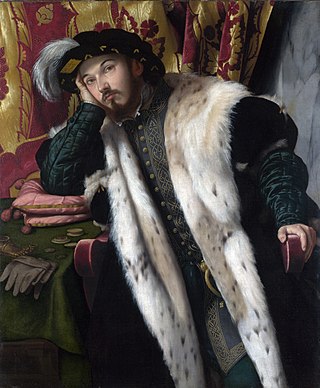
The Bergamasque and Brescian Renaissance is one of the main variations of Renaissance art in Italy. The importance of the two cities on the art scene only expanded from the 16th century onward, when foreign and local artists gave rise to an original synthesis of Lombard and Venetian modes, due in part to the two cities' particular geographical position: the last outpost of the Serenissima on the mainland for Bergamo and a disputed territory between Milan and Venice for Brescia.

The Martinengo mausoleum is a funerary monument made through the use of various marbles and bronze by Gasparo Cairano, Bernardino delle Croci and probably the Sanmicheli workshop, dated between 1503 and 1518 and preserved in the museum of Santa Giulia in Brescia, in the nuns' choir.

















